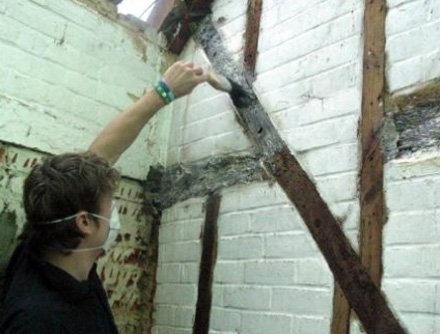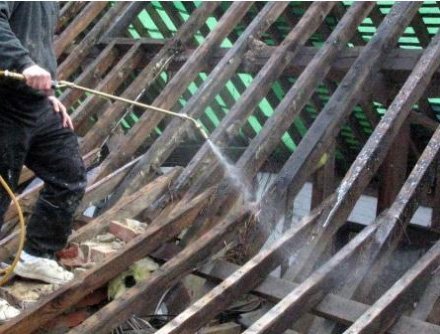The 300-year-old White Barn was an interesting project for us. The initial inspection was requested by the owner and coincided with works being carried out to remove and replace the old quarry tiles on the roof.
The survey was conducted from the ground up, revealing evidence of infestation from three species of beetle:
- Common Furniture Beetle (Anobium Punctatum)
- Powder Post Beetle (Lyctus Brunneus)
- Waney Edge Beetle, or ‘Bark Borer’ (Emobius Mollis)

Powder Post Beetle – Lyctus Brunneus

Waney Edge Beetle (Bark Borer) – Emobius Mollis

Common Furniture Beetle –
Anobium Punctatum
Insect attacks had affected nearly all of the structural timbers within the barn, also spreading to window frames. The majority of woodworm activity was dormant but several high-level areas produced evidence of live pests – this was ascertained when loose, light coloured frass (dust) was released from the timbers by a gentle tap.
The property also had an adjoining barn area which had been converted for habitable use some years ago. Whilst at the site, our team inspected this area too and found it to be free from active woodworm. Obviously, the treatment carried out to that area had been a success.
The treatment required within the infected barn was discussed with the owner and was scheduled to commence at a weekend when his own builders and roofers were offsite. The chemicals used in this treatment have a very low toxicity and permit a 1-hour re-entry. When added to the 5 hours of application effort, it was agreed that the work should be carried out on a Saturday to cause the least amount of disruption to the customer’s building works.
The eradication of the woodworm infestation was tackled with the use of a spray. We also used a paint-on treatment to provide additional antifungal protection against possible future attack from either dry or wet rot. Given the scale of the attack, in this particular instance, the work was performed when all roof tiles and other obstructions were removed in order to maximise penetration of the spray.
- Step 1 – The water tank and adjoining small kitchen area were protected with polyethene sheeting prior to the commencement of chemical spraying
- Step 2 – All timbers were exposed by the client’s own builder and were then sprayed from above and below to ensure all surfaces were treated. Corner and wall joints were also targeted to provide a comprehensive result
- Step 3 – The infested timbers were treated with Tribor Plus, a gel often referred to as ‘mayonnaise’ in the trade. This material is deeper penetrating and complements the spray treatment, containing antifungal agents to help protect against future attacks from both dry and wet rot
- Step 4 – The protective sheeting was removed from the water tank and kitchen area once the airborne chemicals had dissipated
We hope this case study was informative and useful to you. If you have any feedback, queries or questions, please drop us an email at info@dampproofing-london.co.uk.
Case Studies
-
2022 British Standards for East London Flooded Basement
The weather in London in 2021 was particularly wet, or so it felt in a property in Leyton, East London,…
-
Bespoke Waterproofing for High-End London Shop Unit
When the basement area of a high-end shop in Chelsea was found to be inches deep in water, one too…
-
Standard Damp Proofing – Windsor SL4
The client instructed Garratt’s to conduct a damp survey and offer considerations related to any remedial works as required. The…
Recent
-
18 Mar 2024
How to Get Rid of Damp in Bedrooms
While it may seem more logical that kitchens and bathrooms are more prone to damp, it may be surprising for…
-
13 Nov 2023
Benefits of Tanking Your Basement
While basements have been a staple of home construction in multiple countries, they are still a relatively new concept in…
-
13 Nov 2023
Taking Action on Fixing Damp
Damp is a widespread problem in properties across the UK; however, this doesn’t stop the fact that it’s a serious…









